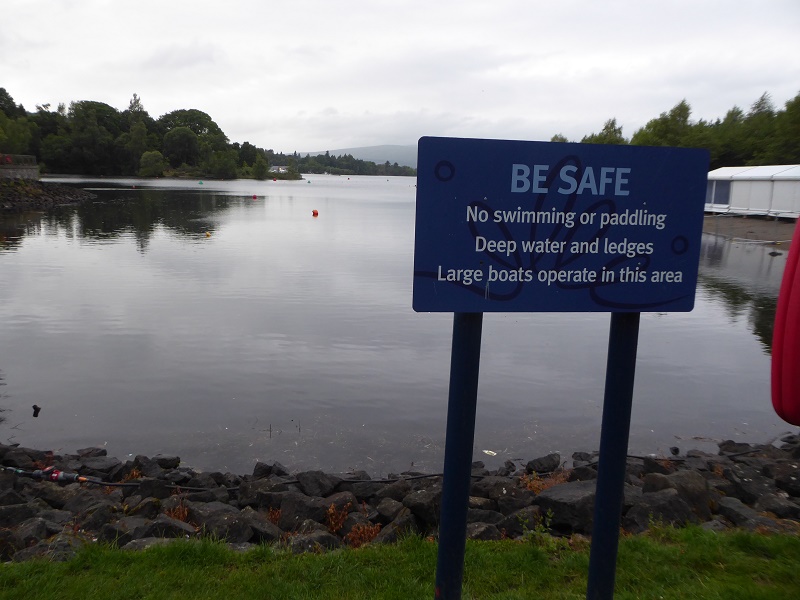
Listening to Radio Scotland on Wednesday, I heard a reporter extolling the wonders of Loch Lomond as the venue for the European open water swimming championships which takes place over four days starting on Wednesday 8th August (see here). Spectating at the event is free of charge and unticketed. The Reporter seemed blissfully aware of any of the issues surrounding the organisation of the championships at Balloch, let alone of the plans to sell off the Riverside Site to a holiday resort. This post takes a look at what has been going on.
The dredging of Drumkinnon bay
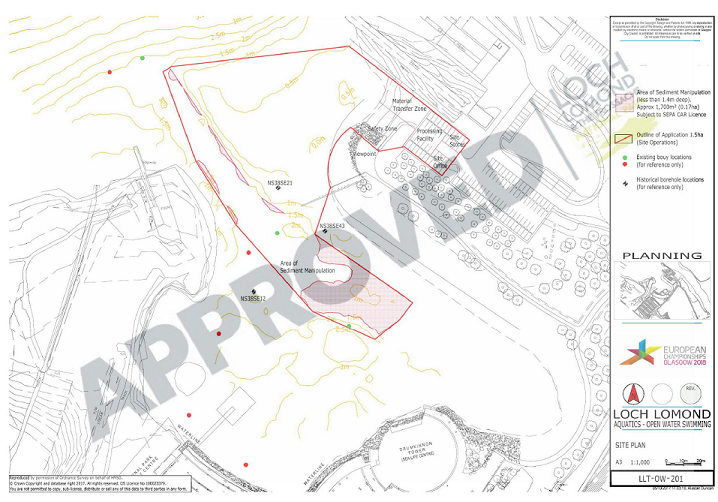
Sometime after it had been agreed that Balloch would be the ideal setting for the European Open Water swimming championships it appears that someone realised that the bay was not deep enough for the event (it needs to be safe for swimmers to dive in) and would need to be dredged. This had environmental implications and required both Planning Permission from the Loch Lomond and Trossachs National Park Authority and a license from the Scottish Environment Protection agency.
In early July, there were just five documents relating to the planning application, which was agreed back in January, on the LLTNPA’s planning portal. Most of the original application documents had been removed and, as is typical for the LLTNPA, none of the documents that Glasgow City Council, as organiser of the European Championships, was required to submit as a condition of the planning consent had been published. It was therefore very hard to understand the basis of the decision. I was particularly interested in seeing two documents mentioned in the planning consent:
- the Ecological Assessment,because in the past Drumkinnon Bay was known as an important spawning area for powan, perhaps the most special of all Loch Lomond’s fish and protected (its an offence to recklessly disturb them)
- and the Public Access Management Plan because in early July a man had drowned in the area where works had been carried out
I therefore asked the LLTNPA for all these documents on 7th July and am pleased to say that they emailed me on 23rd to say they had been published on the planning portal (see here):
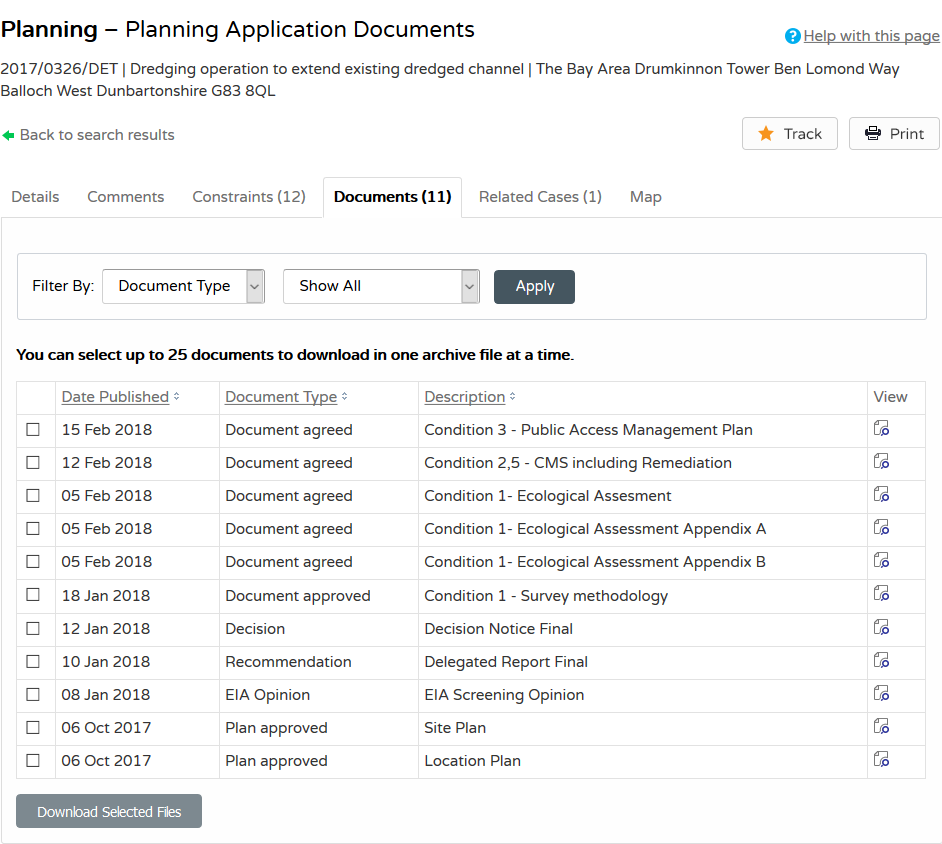
Unfortunately this small positive move in the right direction in terms of planning transparency has been spoiled by the LLTNPA uploading the documents with a February publication date This is false as all the documents relating to conditions 1,2 and 3 were published sometime between 7th and 23rd July (I have emails to prove it) and were effectively secret before then.
The ecological assessment turns out to have involved 21 underwater survey points none of which were found to include powan breeding habitat (like a number of other fish species powan spawn on gravelly beds without too much silt). Good news for the organisers of the open water championships but less good news for Loch Lomond as it appears there may now no longer be any habitats suitable for powan in the area. Many of the photos also show the presence of Canadian Pondweed, an invasive species which SNH has classified as a threat to native wildlife. Reading this assessment confirms that this part of Loch Lomond is anything but in good ecological health.
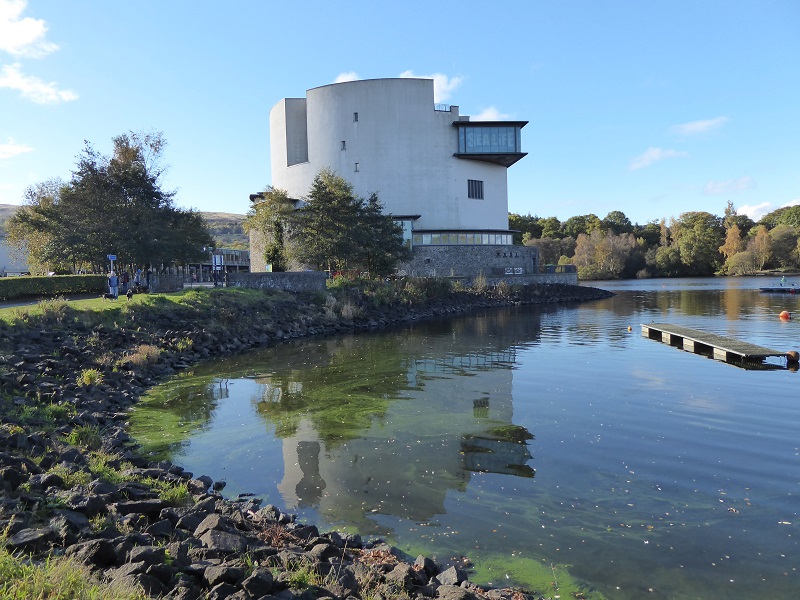
Its striking how the whole planning application was rushed through. It must be highly unusual for a Planning Authority to issue an opinion about the need for an Environmental Impact Assessment (the conclusion was none was required) and then issue a full decision two days later but, perhaps in the rush, the LLTNPA forgot they had a legal requirement to issue an EIA screening opinion? Surveys of specially protected species are also usually required BEFORE planning permission is given (e.g the Flamingo Land application for planning in principle includes otter and water vole surveys) rather than afterwards as in this case. I have had a look at similar cases and in the case of the Cameron House marina pontoon extension approved in 2015 (see here), a far less extensive proposal than this dredging, the officer advised the applicant to seek information about the potential impact of the works on fish breeding and then included this in the decision report:
It was recommended that the applicant seek advice from Loch Lomond Fisheries Trust regarding the potential for spawning areas in the vicinity of the proposed development. They have since confirmed that there is low potential for spawning areas within the marina but advise that there are two small burns which run into the bay of the marina that may be used by spawning Salmonids between September and January.
There is NO reference to any such advice being sought in this case nor of any consultation taking place apart from with the Scottish Environment Protection Agency.
Then, after planning permission was granted with the condition an ecological survey was conducted, the impression given by the Park is that their priority was to minimise the amount of survey work required “Hopefully to narrow down the survey work required please refer more to my notes below” (see here) rather than establish what the actual impacts of the dredging might be.
It appears therefore that significant shortcuts were taken in this case. Questions that arise from this are:
- Why did the LLTNPA need to take shortcuts when there had been years to prepare?
- Why did the LLTNPA not give proper regard to its statutory conservation objectives in this case?
- And, how does this fit with the quality planning awards that the LLTNPA continues to receive?
Similar questions could be asked of SEPA and how they processed the application:
SEPA have advised that they have no objections to this proposal and have advised that:
- This activity would require a simple licence under The Water Environment (Controlled Activities) (Scotland) Regulations 2011 (as amended) (CAR) and, based on the information received to date, SEPA consider this activity is potentially consentable under CAR. (extract from planning report).
Simple licences cover minor operations, such as ditch improvements, and are granted on condition people adhere to the rules set out for various operations. Included under simple licences is “Removal of sand, silt or clay from the bed (ie dredging) of previously straightened rivers and burns which are ≥1m and <5m wide. Up to 500m length along the bed may be removed”. Dredging in lochs is not mentioned under guidance to the simple car Licence.
Dredging in lochs however is mentioned in CAR A practical Guide:
Complex licence activities
1. Sediment management in watercourses greater than 3m wide over a length of more
than 50m. This includes sediment removal such as dredging, gravel extraction and
sediment movement within the channel (e.g. pool maintenance works).
2. Sediment management in lochs greater than 500m2 in total area.
That’s pretty clear as is the Planning Report which states “The total site area is 1.5 hectares and the area of proposed dredging works is approximately 0.17 hectares”. In other words, the area to be dredged was 1700 square metres, well over the 500 square metre area where a complex license would be required.
So, why did SEPA contravene their own guidance and advise the LLTNPA only a simple CAR license would be required?
The consequences of the dredging of Drumkinnon Bay
At the beginning of July, after the dredging work had been completed, Rebin Rehan, who the Daily Record described as a Kurdish Student, drowned in the area that had been affected by dredging operations (see here). While Loch Lomond is a notoriously dangerous place to swim (and another young person sadly drowned near Luss a few days later), it appears that this accident could have been a consequence of the dredging. The dredging operation was wider than originally intended – in order to get the barges into the area to be dredged a new channel was apparently constructed – and this has in effect created a hidden underwater cliff.
That the accident was a consequence of this man stepping off the cliff would fit with the police description as quoted in the press: “He had been seen panicking in the water and went under and did not come up”.
While another news piece (see here) showed a warning sign about the hidden cliff face by the shore, posts on the Friends of Drumkinnon Wood Facebook Page (the group cancelled two events as a mark of respect for the man) suggested these were the only signs in place at the time and they were not obvious.. If that is the case, that should be of considerable interest to the Fatal Accident Inquiry which I believe now needs to take place.
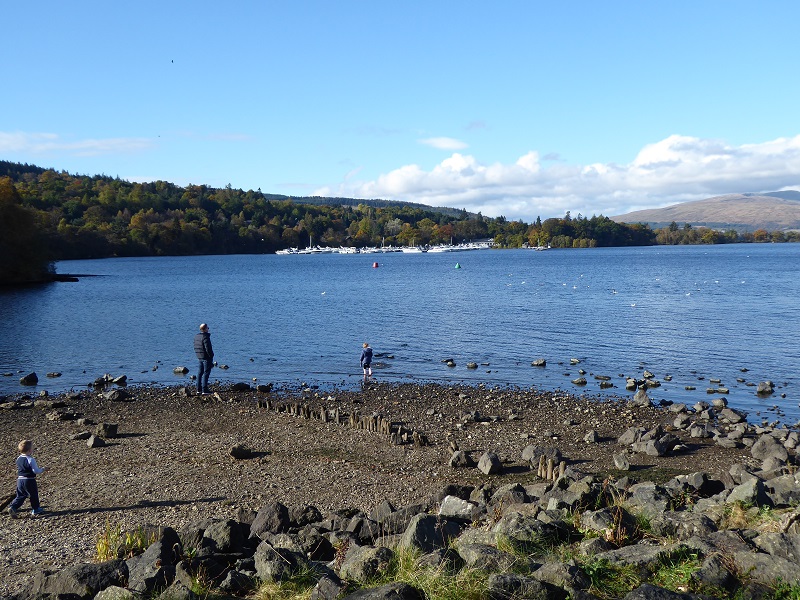
The shoreline by the dredged area where the championships are being held was a very popular place for paddling and, without extensive signage to warn of the new danger, people who had previously paddled or swum here would be taken totally by surprise by the new underwater cliff.
There is nothing on the LLTNPA planning portal to suggest that the LLTNPA considered the recreational consequences of the dredging work. The Construction Method Statement which has now been made public shows that care and attention was given to the health and safety of the public while the works were taking place. The contractor would appear therefore to be blameless. There is however nothing about what should happen after the works had finished and the contractor moved off site. Responsibility for considering this would appear to lie somewhere between the LLTNPA, Scottish Enterprise as owner of the land, Lomond Shores whose name appeared on the sign which was put up and Glasgow City Council which has had temporary custodianship of the area.
Now, I am not an advocate of smothering the countryside in Health and Safety signs. We have access rights on the basis that it is generally the individual’s responsibility to evaluate risks associated with recreation activities, including paddling and swimming. Indeed, I believe that many of the signs, along with lifebelts, which have appeared at hydro intakes, where the risks are generally quite obvious, are unnecessary.
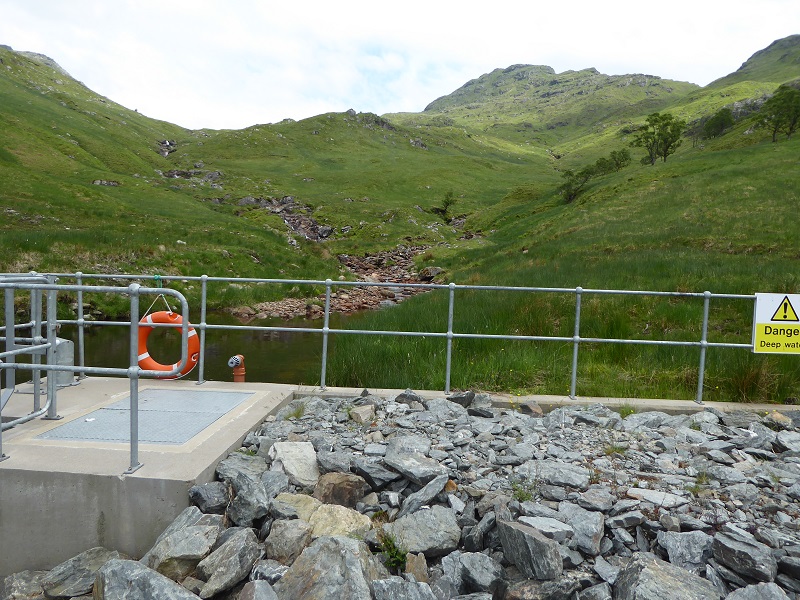
These signs have presumably be erected on the basis that a pool has been created artificially. I believe the risks here are pretty obvious and you should take similar care whether entering an artificial or a natural pool. However, its a completely different matter where land has been modified to create hidden dangers. That is why hazards such as mineshafts and the edges of quarries are generally fenced off and warning signs put in place. Similar precautionary measures should have been put in place at Drumkinnon Bay following the dredging and its not clear they were.
If they weren’t, I don’t think this is the responsibility of the frontline staff concerned but rather of the powers that be who rushed through this work. To me the European championships have been overshadowed by this terrible event which should have been avoidable. It will be interesting to see they open with a 1 minute silence in memory of Rebin Rehan.
Lomond Shores gets a facelift
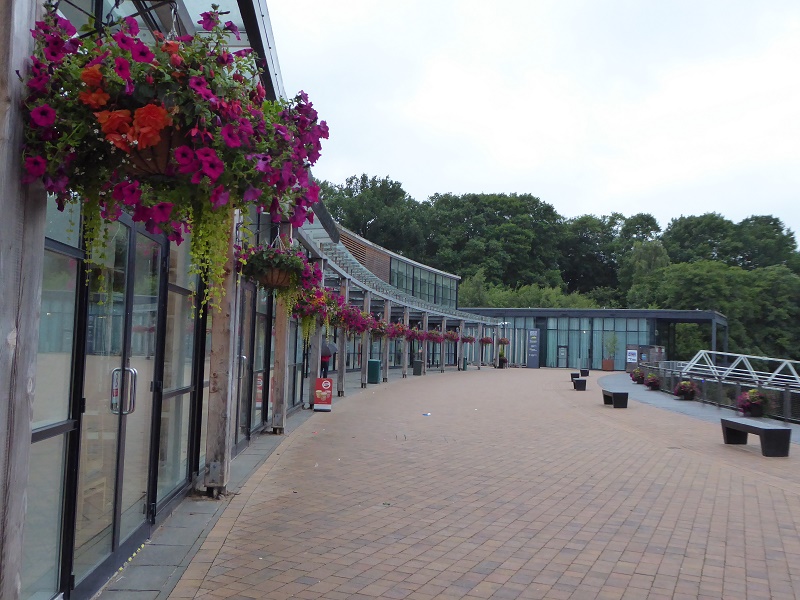
I shouldn’t have been surprised on Tuesday to find Lomond Shores transformed for the event with flower baskets and additional flower tubs. Even the car park had been beautified.

It looks good, makes a real difference and every Scottish town should be like this. I could not help thinking though of what happened in the Spring when West Dunbartonshire Council decided it could no longer afford to maintain flower beds. It decided to grass over flower beds and cut other services such as litter picking (see here). So why now all the flowers? On the one hand people are told there is no money and cuts must be accepted, on the other money is no object.
Let’s hope that the flowers stay after the European Championships and the hyprocrisy of improving places only for prestigious events and where money is at stake is exposed for what it is.
Addendum – spoke too soon!

Thanks to Kenny Gibson who sent this photo of Lomond Shores on Saturday. The baskets have gone! As he remarked “Maybe some cost efficiencies are being introduced and they’ve been shipped of to another venue , returning Wednesday for the start of this event.”
The Drumkinnon bay trees
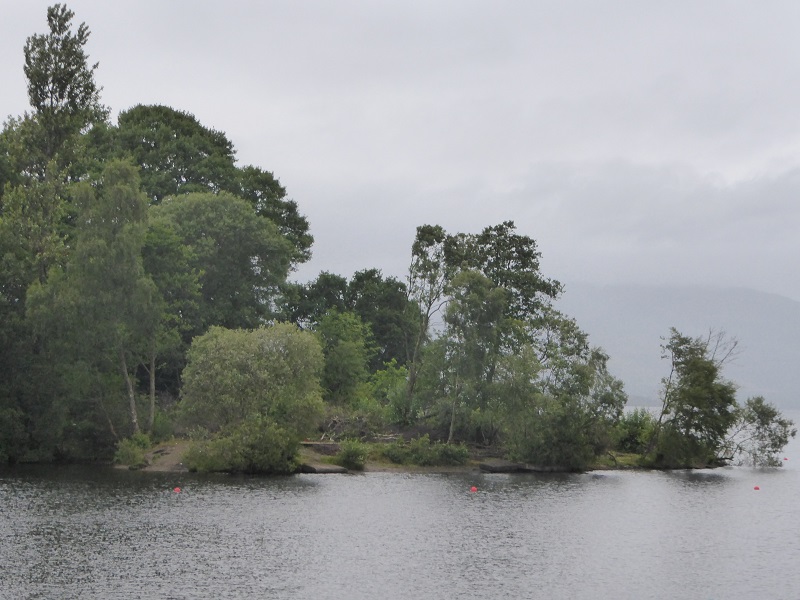 As far as I am aware, the silence from the police on the progress of their investigations into who was responsible for the butchering the trees at Drumkinnon Bay (see here) continues.
As far as I am aware, the silence from the police on the progress of their investigations into who was responsible for the butchering the trees at Drumkinnon Bay (see here) continues.
Viewing the area now from Loch Lomond Shores, unless you look carefully, you might not know that anything had happened . The organisers of the European Open Water Swimming Championships and the LLTNPA must be breathing a sigh of relief because world wide coverage of the destruction would have rather spoiled the marketing pitch:
“As the Open Water Swimming venue for Glasgow 2018, Loch Lomond & The Trossachs National Park promises to showcase exciting sporting action amongst some of the most stunning scenery in the whole of Scotland.”
Or raised questions internationally about the extent to which this stunning scenery is being properly protected by the National Park. Television cameras however have powerful lenses……………and maybe, just maybe, someone will start asking questions as to who was behind this.
And the Flamingo Land planning application…………….
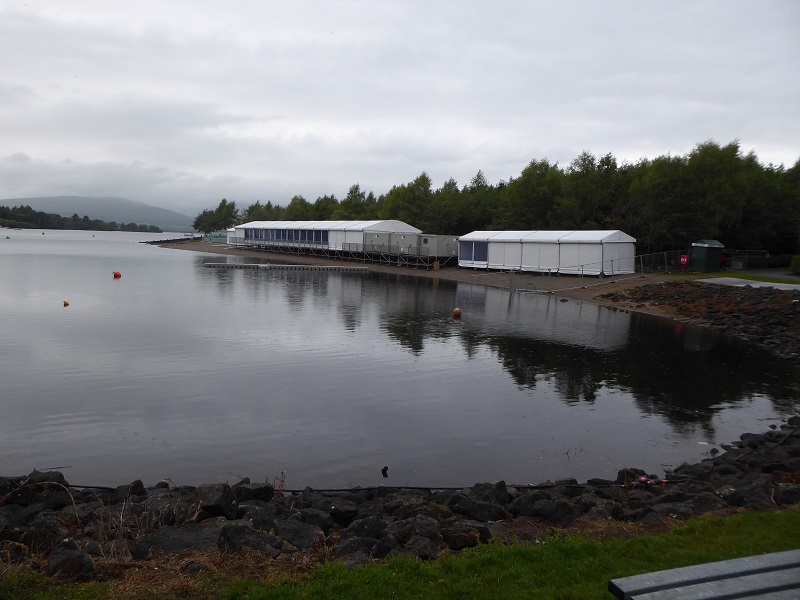
The temporary facilities for the Open Water Swimming Championships help provide a taste of what this site might look like if the Flamingo Land planning application were to be approved. While the application for planning permission in principle gives little indication of what the buildings will look like, it is proposed the area behind the marquees will become a hotel and leisure complex. What is currently public land, normally open to all, will become private and out of bounds.
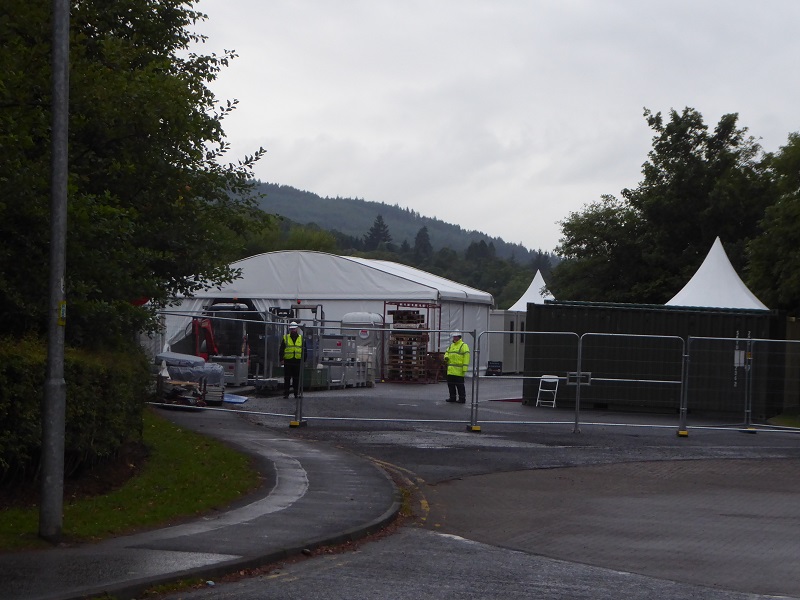
The exclusion of the public from the site in this way is almost certainly unlawful. Most of the ground here is covered by access rights and in order to exclude people from the land or loch, the LLTNPA as Access Authority should have make a Section 11 Order under the Land Reform Act (as for example happened when the G8 met at Glen Eagles). I can find no references or consideration in the Planning Report to the need for such an order, nothing on the LLTNPA website and nothing in the business of the Planning and Access Committee for this year. While I don’t believe anyone would have objected to such an order, the failure of the LLTNPA to respect the statutory framework for access rights should come as no surprise. Their senior management team have shown no respect for access rights and bludgeon through whatever they want to happen without regard for people’s rights or the law (see here).
This disregard for the law will also, however, potentially make the LLTNPA liable for the accident that has occurred and any future accidents: the new No Swimming signs that have been erected, like the many no camping signs that litter the National Park, are legally meaningless without an appropriate order under our Access legislation. If Park Rangers see people swimming here, they can do nothing legally to stop them as long as the water is covered by access rights. So much for the LLTNPA taking appropriate precautions to prevent accidents.
What needs to happen
The way the European Outdoor swimming championships have been organised threatens to bring both Glasgow, which has established a world-class reputation for organising sporting events, and the Loch Lomond and Trossachs National Park Authority into disrepute. Primary responsibility for this lies with the LLTNPA which, instead of immediately supporting the proposal that the European open water swimming championships should be held at Balloch, should have insisted that it would need time and resources to establish whether the location was suitable. Having properly investigated the site and other options it could then have made a decision. I am sure somewhere suitable would have been found on Loch Lomond. I am not against holding events like this in National Parks but believe the LLTNPA had a duty to ensure these are done properly and in a way that does not undermine its other objectives.
Through its reckless approach the LLTNPA has put both itself, as a national body with statutory responsibilities, and the open water swimming championships at risk: imagine what would have happened if the ecological surveys in January/February had found powan breeding habitat? Glasgow would have been put in an impossible position, either responsible for destroying the natural habitat that was being used to promote the championships or forced to find another venue at impossibly short notice. The future ability of Glasgow to host international sporting events in future would have been threatened.
Part of the reason for the failure of the LLTNPA to plan properly is that a large proportion of their resources have been diverted to the introduction and enforcement of the camping byelaws, to the detriment of everything else. They no longer have the staff with time or expertise to ensure that species like powan are protected let alone to work on how to protect habitats more widely because they are too busy chasing campers. The remaining staff are then forced to take short-cuts which are then made worse when, as a result of poor planning, they are given impossible timescales.
As a consequence of these failures I believe there now needs to be a Scottish Parliament enquiry into the handling of the championships by the LLTNPA whose remit should be to look at what has gone wrong and what needs to change in the National Park. Among the questions/issues the enquiry should consider are:
- What planning and resources are needed before events like this are held in the National Park in future?
- Could the LLTNPA have done more to protect the trees that were felled at Drumkinnon Bay?
- Was the approach taken by the LLTNPA towards the dredging of Drumkinnon Bay compatible with its conservation objectives?
- How could health and safety processes be improved to reduce the likelihood of drowning accidents in future?
- Why didn’t the LLTNPA take steps to exempt the land and water needed for the championships from access rights using the statutory framework set out in the Land Reform Act?
- Did the LLTNPA play any role in the temporary beautification of Lomond Shores and if so how was this decided?

Spot on, Nick. There is a very large broom sweeping a massive amount of dirt under a very thick carpet, A pity nobody notices the bumps.
Yet again the park has failed, how many chances are these people allowed ?digging underwater ledges are these people completely clueless do they all work together to come up with this sh?? Rent a flower a joke yes .
Well looks like they are neglecting other areas of the park…loch earn camping zones are in a dreadful mess today after the weekend…..broken glass .piles of rubbish left everywhere.and toilet waste..permits are not working .they have made these zones and packed people into small areas.which has created more problems than before the ban .also today I have heard that the parks want to close some lay-bys on the north shore …I await their response from my email but won’t hold my breath
Hi Graeme, thanks for this, agree totally about byelaws concentrating impacts………….would be interested in seeing response to your question from the LLTNPA and will follow up, Nick
Has the dredged area of drumkinnon bay been reinstated, if not the people in charge are guilty of criminal negligence.